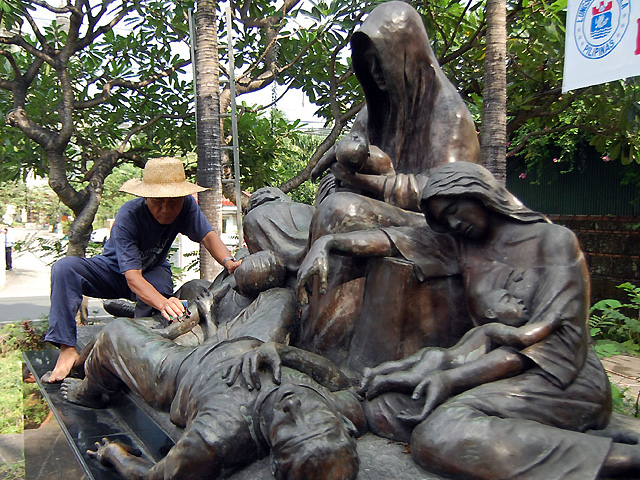Filtered By: Lifestyle
Lifestyle
Battle of Manila remembered
By CARMELA G. LAPEÑA, GMA News
February 1945 marked the end of the Japanese military occupation of the Philippines. In what is referred to as the "Liberation of Manila," American and Filipino forces fought against the Japanese, who occupied the city in 1942 after the attack on Pearl Harbor in December 1941.
But in this so-called liberation, thousands of Filipino men, women and children died in the struggle, which is remembered as the "Battle of Manila." The formerly beautiful city was destroyed. Buildings were reduced to rubble, schools and churches burned to the ground. Heritage sites, like the University of Sto. Tomas campus, were used to hold civilians, and were also damaged in the battle.
In his essay "Caught in the Battle of Manila," survivor Dr. Joseph Romero recalls an eerie sky of smoke and flames, with "glowing bits of paper sailing like leaves against the orange-black sky.
Then eleven years old, Romero lived in Ermita with his American mother and Filipino stepfather. They left their house and saw hundreds of people being assembled by the Japanese. There was danger in the air and on the ground, where aerial bombs were buried, fuse head up.
Romero wrote that the Japanese were shoving men to the left and women and children to the right. His father, who pushed him to the right, later said that the men were walked to Manila Hotel, then later stacked in groups of 30, baled with wire and doused with gasoline. A grenade would then be thrown in.
Meanwhile, the women and children were brought to Bayview Hotel, soldiers on each side pointing bayonets at them. They were shoved into rooms, where they were kept safe from the continuous pounding of artillery outside. Romero recalls how "the building shook, noise deafening, flashes of light all night."
Filipinos were caught in the middle of both forces. Romero recalls how they attached a sheet with a large red cross to a ruined building. "We poor souls thought this would save us from friendly fire. The Americans opened up on our feeble ruin," he wrote.
Romero wrote of the horror—babies thrown in the air and bayoneted, young girls raped, thousands of civilians killed. "Dante would have been inspired. Flames, blue smoke, bodies or parts thereof all over the place. A mother carrying the upper part of her four or five year old daughter, while another daughter carried the child's leg. The three of them dazed and wandering, scared, hysterical, crying, shocked. The little one still alive but unresponsive. The fire getting hotter and hotter."

A park utility man cleans the Memorare Manila Monument in Intramuros on Thursday in preparation for the 67th anniversary of the Battle of Manila during World War II. Danny Pata
A hundred thousand dead
The month-long confrontation ended with 100,000 Filipinos dead, second only to Russia's Stalingrad City, making it one of the highest civilian casualties in urban combat of any World War II battle.
The Public Broadcasting Service notes that the American bombardment may have killed more people than the Japanese did, and certainly caused more physical damage. "But whatever the factors which conspired to cause it, the destruction of Manila stands as one of the great tragedies of the Second World War," says PBS on its website.
In his analysis of the Battle of Manila written for the US Combat Studies Institute, Dr. Thomas Huber says that much of the city was already fortified by the Japanese defenders when US forces reached Manila on February 3.
Commanded by General Tomoyuki Yamashita, Lieutenant General Shizuo Yokoyama ordered the Japanese army forces to evacuate from Manila to Northern Luzon. Yokoyama was responsible for Manila, including Japanese naval forces in the area. However, Southwestern Area Fleet Vice Admiral Denshichi Okochi, who did not report to Yamashita's 14th Area Army, ordered naval personnel to defend naval facilities in Manila.
Huber said that as Americans approached Manila, Japanese army troops were moving out while Japanese naval troops were moving in. This led to the month-long confrontation, which ended with the Americans bombarding the Japanese stronghold of Intramuros. With almost all of the 37th Infantry Division's artillery assets, 30 machine guns and over 7,000 high explosive shells were dropped on Intramuros.
On February 3, the Americans breached the thick walls, and 2,000 women and children flowed from Del Monico Church on General Luna Street, where the Japanese had been holding them. Huber writes that "the male civilians had evidently been separated by the Japanese, detained in Fort Santiago, and executed there en masse."
At the corner of General Luna and Anda in Intramuros, a monument stands at the Plaza de Santa Isabel. The Shrine of Freedom is dedicated to all the victims, who have gone nameless and unknown, many of them without a grave.
"Let this monument be the gravestone for each and every one of the over 100,000 men, women, children and infants killed in Manila during its battle of liberation, February 3-March 3, 1945. We have not forgotten them, nor shall we ever forget," a marker at the shrine showed.
Requiem Mass
On February 13, 2012, a requiem Mass will be held to pay tribute to the victims of the Battle of Manila.
The Catholic Bishops' Conference of the Philippines said military bishop Leopoldo Tumulak will lead the service at the Manila Cathedral in Intramuros at 10 a.m.
“We want to remember those people who have died and forgotten somehow, so they would know that there are still people who remember them,” said Carlos Oda, deputy executive director of the Prayer for Warriors of the Holy Souls, a lay Catholic group. –KG, GMA News
More Videos
Most Popular




